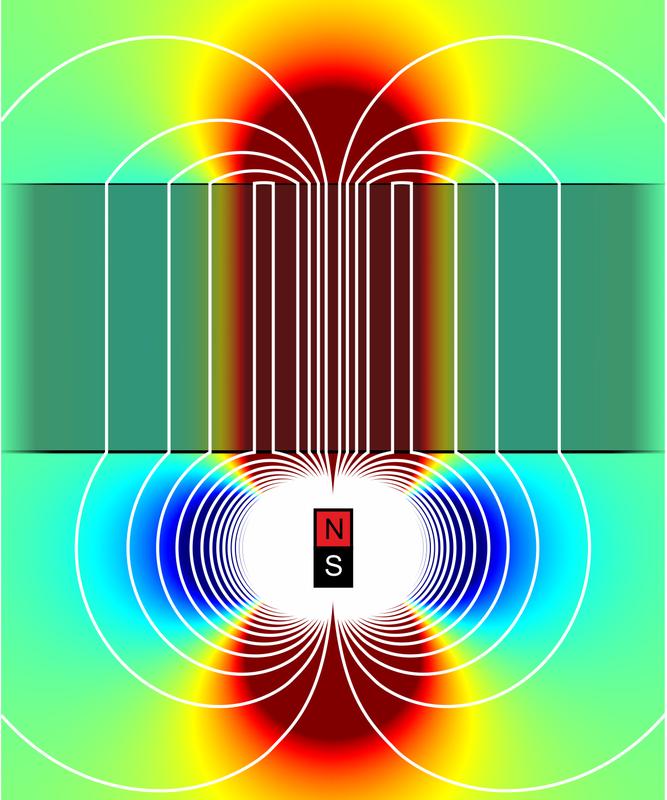Innovation: Magnetic Field Conductors

A new technology transfers magnetic fields to arbitrary long distances, which is comparable to transmitting and routing light in optical fibers. Universitat Autònoma de Barcelona
Oriol Romero-Isart and his colleagues have theoretically proposed and already tested this new device experimentally. The field of possible applications is broad and includes spintronic and quantum computers among others.
In today’s high-tech world, transferring electromagnetic waves is essential for many technologies. This can be seen with information being circulated worldwide via optic fibers. However, a device capable of doing this with static magnetic fields does not exist as the transferred field rapidly decays with distance from the source. In Innsbruck, theoretical physicist Oriol Romero-Isart and his colleagues have now found a surprisingly simple solution for this problem.
Magnetic hose
“Our theoretical studies have shown that we need a material with extreme anisotropic properties to transfer and route static magnetic fields,” explains theoretical physicist Romero-Isart. This means that the material has to have extremely good permeability in one direction but zero in the perpendicular direction. Since no material exists with such extreme anisotropy, the physicists designed a different strategy: They used a ferromagnetic cylinder and wrapped it with a superconductor shell. “Superconductors are perfect magnetic insulators,” explains Romero-Isart. The researcher’s calculations showed that a structure of alternated superconducting and soft ferromagnetic concentric cylindrical layers could transfer more than 90% of the magnetic field to any distance. Remarkably, the researchers also calculated that up to 75 % of the magnetic field can be transferred by using only a bilayer scheme – a ferromagnetic core with a superconducting outer layer.
Proof-of-principle experiment
After theoretically proposing this scheme, the team experimentally demonstrated such a device. They wrapped a ferromagnet made of cobalt and iron with a high-temperature superconductor and conducted several tests. “Even though our technical set-up wasn’t perfect, we could show that the static magnetic field is transferred well by the hose,” says Prof. Sanchez, the Catalan group leader of Oriol Romero-Isart’s collaborators.
This new method could be used, for example, for future quantum technology coupling distant quantum systems magnetically, applications in spintronics and other nano technologies.
The work of the physicists from the Universitat Autonoma de Barcelona, the Max-Planck-Institute of Quantum Optics, the Institute for Quantum Optics and Quantum Information of the Austrian Academy of Sciences and the Institute for Theoretical Physics of the University of Innsbruck has been published in the renowned journal Physical Review Letters. The project is funded by the European Union and the European Research Council among others.
Publication: Long-distance Transfer and Routing of Static Magnetic Fields. C. Navau, J. Prat-Camps, O. Romero-Isart, J. I. Cirac, and A. Sanchez. Phys. Rev. Lett. 112, 253901
DOI: 10.1103/PhysRevLett.112.253901 (arXiv:1304.6300v2)
Contact
Univ.-Prof. Dr. Oriol Romero-Isart
Institute for Quantum Optics and Quantum Information
Austrian Academy of Sciences
phone: +43 512 507 4730
email: oriol.romero-isart@uibk.ac.at
web: http://iqoqi.at/en/group-page-romero-isart
Christian Flatz
Public Relations
University of Innsbruck
phone: +43 512 507 32022
email: christian.flatz@uibk.ac.at
Weitere Informationen:
http://dx.doi.org/10.1103/PhysRevLett.112.253901 – Long-distance Transfer and Routing of Static Magnetic Fields. C. Navau, J. Prat-Camps, O. Romero-Isart, J. I. Cirac, and A. Sanchez. Phys. Rev. Lett. 112, 253901
http://arxiv.org/abs/1304.6300v2 – arXiv:1304.6300v2
http://iqoqi.at/en/group-page-romero-isart – Quantum Nanophysics, Optics and Information
Media Contact
All latest news from the category: Physics and Astronomy
This area deals with the fundamental laws and building blocks of nature and how they interact, the properties and the behavior of matter, and research into space and time and their structures.
innovations-report provides in-depth reports and articles on subjects such as astrophysics, laser technologies, nuclear, quantum, particle and solid-state physics, nanotechnologies, planetary research and findings (Mars, Venus) and developments related to the Hubble Telescope.
Newest articles

Properties of new materials for microchips
… can now be measured well. Reseachers of Delft University of Technology demonstrated measuring performance properties of ultrathin silicon membranes. Making ever smaller and more powerful chips requires new ultrathin…

Floating solar’s potential
… to support sustainable development by addressing climate, water, and energy goals holistically. A new study published this week in Nature Energy raises the potential for floating solar photovoltaics (FPV)…

Skyrmions move at record speeds
… a step towards the computing of the future. An international research team led by scientists from the CNRS1 has discovered that the magnetic nanobubbles2 known as skyrmions can be…





















